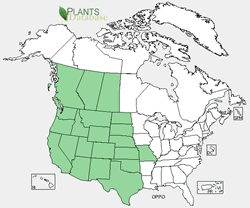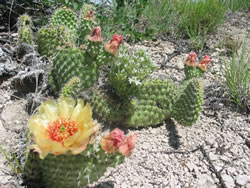Plant of the Week
 Opuntia polyacantha range map. USDA PLANTS Database.
Opuntia polyacantha range map. USDA PLANTS Database.
 Close-up of the Opuntia polyacantha flower. Photo by Mary Lata and Rana Tucker.
Close-up of the Opuntia polyacantha flower. Photo by Mary Lata and Rana Tucker.
 Great Plains prickly pear (Opuntia polyacantha). Photo by Mary Lata and Rana Tucker.
Great Plains prickly pear (Opuntia polyacantha). Photo by Mary Lata and Rana Tucker.
Great Plains Prickly Pear (Opuntia polyacantha)
By Mara Lata and Rana Tucker
Prickly pear species are found in abundance in the West and Southwest of the United States and throughout much of Mexico. Prickly pears are also the only types of cactus natively found to grow in the eastern United States. Opuntias are the most cold tolerant of the lowland cacti, extending into northern Canada.
The flowers are a bright yellow and can be up to 6 inches wide, usually blooming in early to mid-summer. The green cactus “pads” (platyclades) are actually stems that have adapted to survive with very little water. These pads are armed with two kinds of spines; large, smooth, fixed spines and small, hairlike spines called glochids that easily penetrate skin and detach from the plant. Glochids are easily dislodged, difficult to see and even more difficult to remove.
The economic value of Great Plains prickly pear is of little importance in the United States, but in Mexico and the Southwestern United States this plant is a vital source of food and drinks that are derived from the juice, fruits, stems, and flowers. Prickly pear fruits and young flower petals are edible. The fruits or "tunas" are cut in half and seeds removed. They resemble pomegranates in color, taste, and texture, although they have glochids on the outside and must be handled carefully. The tunas can then be eaten raw or used to make jams and jellies. The young petals can be eaten raw or cooked.
A gardener, student, and entomologist, Adrian Haworth (1767-1833), first described the plant in 1819. This plant can be used for food, drink, medicine (treat skin sores, infections, and backaches), a sticky gum, and as a mordant in fixing dyes.

